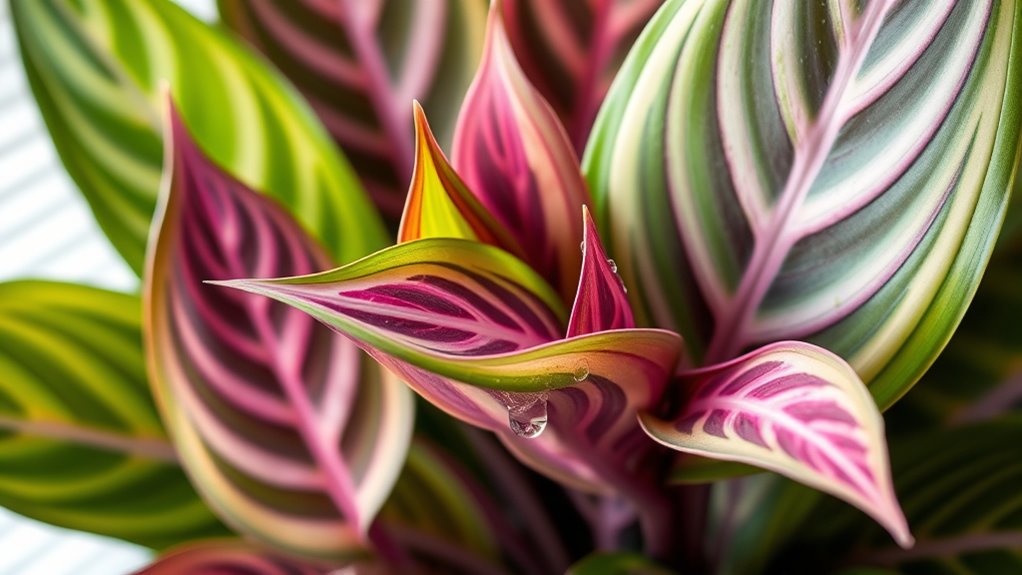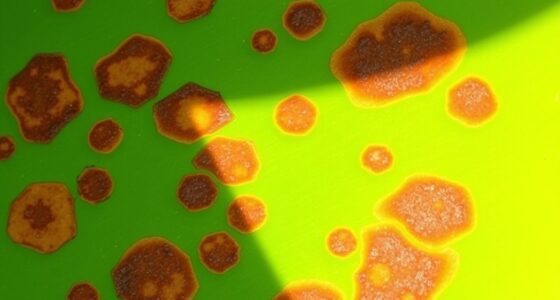If your Calathea’s leaves won’t open, it’s often due to low humidity or insufficient light. Boost humidity by misting, using a humidifier, or placing a pebble tray nearby. Make certain the plant gets bright, indirect light—too much direct sun can hinder unfurling. Keep the soil moist but well-draining, and avoid sudden changes in environment. For more tips on promoting vibrant, open leaves, continue to explore ways to optimize your Calathea’s care.
Key Takeaways
- Ensure the plant receives bright, indirect light to promote leaf unfurling and healthy movement.
- Increase ambient humidity using misting, humidifiers, or pebble trays to prevent leaf curling and dehydration.
- Maintain consistent soil moisture, avoiding water stress that can hinder leaf opening.
- Avoid sudden environmental changes or overwatering, which can stress the plant and delay leaf development.
- Use well-draining soil and proper watering practices to support healthy root function and vibrant leaf activity.
Understanding Calathea Leaf Movement
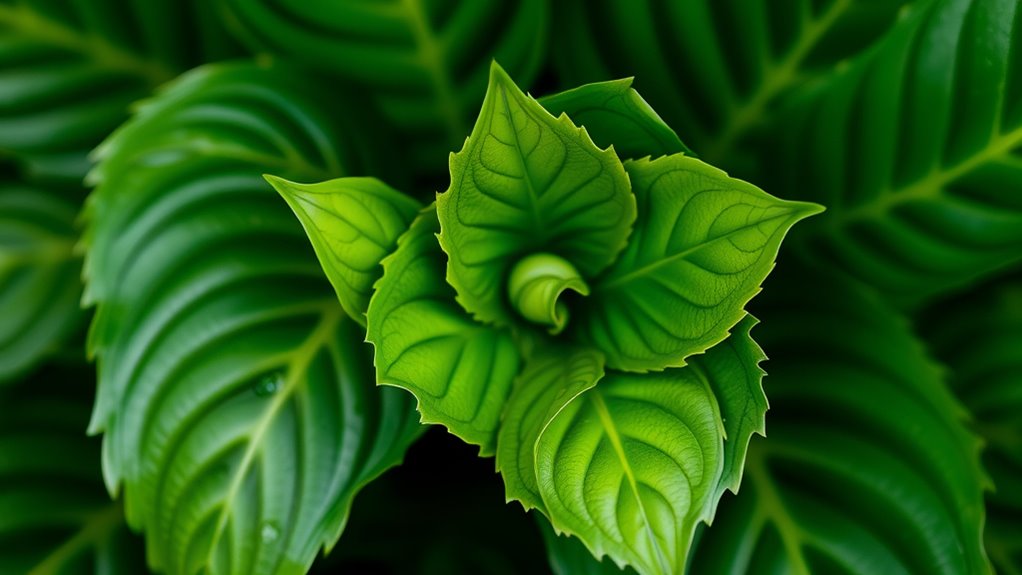
Understanding Calathea leaf movement is key to caring for your plant properly. Calathea leaves often display unique leaf patterns, which can change throughout the day as part of their natural movement. This movement, called nyctinasty, helps the plant adapt to its environment. When leaves fold or curl, it’s usually a sign the plant is responding to light, humidity, or watering conditions. Additionally, soil drainage requirements play an essential role; well-draining soil prevents water from sitting around the roots, reducing stress that could affect leaf movement. By observing how your Calathea’s leaves behave, you can better understand its needs. Proper soil, adequate light, and consistent watering support healthy leaf movement, ensuring your plant stays vibrant and active. Incorporating optimal humidity levels can also significantly improve leaf opening and overall plant health. Maintaining appropriate air circulation can further promote healthy leaf activity and prevent issues like mold or pests, especially since air flow influences humidity and helps prevent fungal problems.
Signs Your Calathea Needs More Humidity
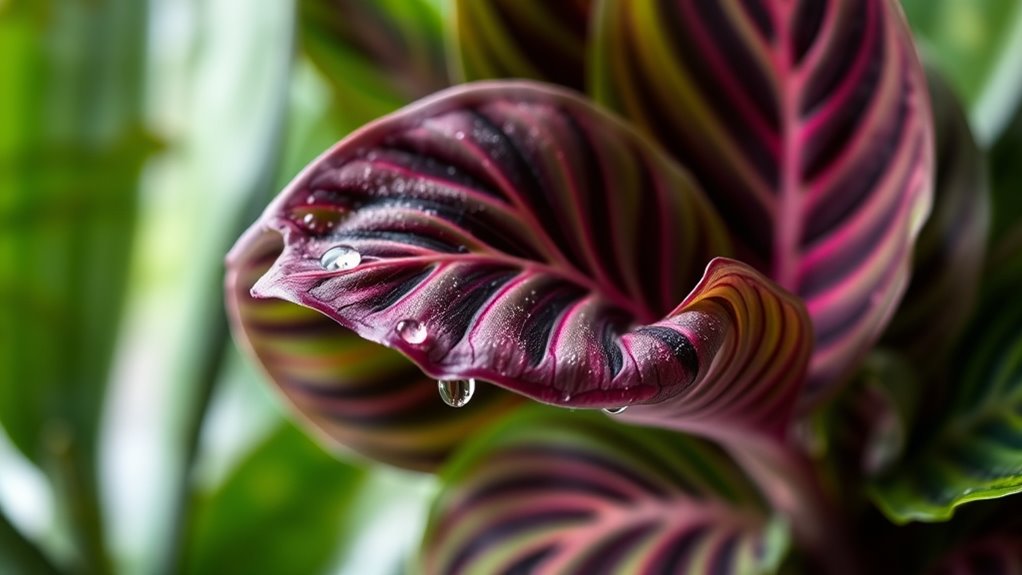
If your Calathea’s leaves start wilting, drooping, or curling, it might be a sign it needs more humidity. Brown edges and limp, curling leaves are also common indicators. Pay attention to these signs to keep your plant healthy and vibrant. Ensuring appropriate humidity levels can prevent these issues and promote lush growth. Proper humidity is essential for Calatheas to thrive indoors.
Wilting or Drooping Leaves
When your Calathea’s leaves start wilting or drooping, it’s often a clear sign that it needs more humidity. Low humidity causes the plant to lose moisture quickly, leading to drooping leaves. To help, review your watering schedule—overwatering or underwatering can worsen the problem. Keep the soil consistently moist but not soggy. Additionally, check your fertilizer frequency; over-fertilizing can stress the plant, while too little can weaken it. If the environment is dry, increase humidity with a humidifier or by placing a tray of water nearby. Regularly misting the leaves also helps. Addressing these humidity issues guarantees your Calathea stays hydrated, firm, and healthy, preventing further drooping and supporting vibrant foliage. Properly selecting the right plant care techniques can also help maintain optimal humidity levels and overall health. Using humidity management methods, such as grouping plants together or using pebble trays, can create a more suitable environment for your Calathea.
Brown Leaf Edges
Have you noticed the edges of your Calathea’s leaves turning brown and crispy? This is a clear sign your plant isn’t getting enough humidity. When the leaf coloration shows brown, dry edges, it indicates dehydration at the leaf margins. Often, this problem stems from a watering schedule that isn’t maintaining consistent moisture levels, causing the plant to dry out. To fix this, increase humidity around your Calathea by misting, using a humidifier, or placing it on a pebble tray. Adjust your watering schedule to ensure the soil stays evenly moist but not soggy. Regularly check the soil’s moisture and avoid letting it dry out completely. Proper humidity and consistent watering will help restore healthy leaf edges and improve overall plant vitality. Additionally, incorporating self watering pots can help maintain consistent moisture levels and prevent dehydration issues.
Implementing humidity trays can also be an effective way to boost ambient moisture and support your Calathea’s health.
Leaf Curling or Limpness
Brown, crispy leaf edges often indicate dehydration, but your Calathea may also show signs of insufficient humidity through leaf curling or limpness. If your plant’s leaves are curling inward or appearing limp, it’s a clear sign it needs more moisture in the air. Calathea leaf curling is a defense mechanism against dry conditions, helping reduce water loss. Similarly, Calathea limpness suggests the plant isn’t absorbing enough water, making it weak and droopy. Increasing humidity around your plant, such as misting, using a humidifier, or placing it on a pebble tray, can help restore its health. Addressing these humidity issues quickly will revive your Calathea and prevent further stress. Keep a close eye on leaf behavior to ensure conducive conditions.
How Light Levels Affect Leaf Unfurling
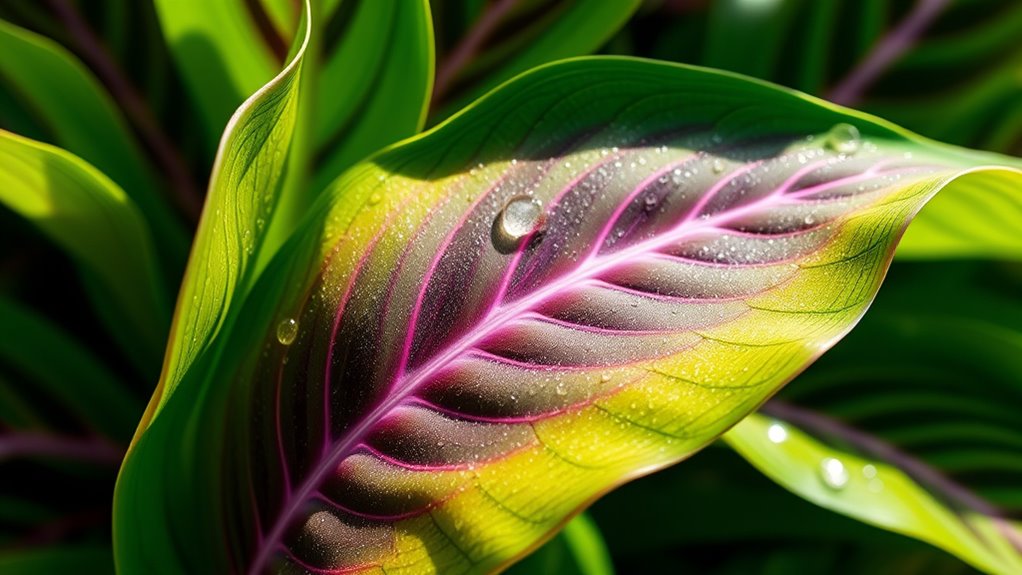
Light levels play a crucial role in whether Calathea leaves unfurl properly. Insufficient light can delay leaf response, causing them to remain closed or curled. Studies in plant growth show that bright, indirect light encourages ideal leaf unfurling by stimulating the plant’s natural growth cycle. Too much direct sunlight, however, can scorch leaves or cause stress, hindering unfurling. Understanding light intensity helps you adjust your setup for excellent growth. Here’s a quick guide:
| Light Intensity | Leaf Response | Recommendations |
|---|---|---|
| Low | Slow or no unfurling | Increase exposure gradually |
| Moderate | Promotes healthy unfurling | Place in bright, indirect light |
| Bright, indirect | Excellent leaf response | Maintain consistent lighting |
| Direct sunlight | Risk of stress or scorching | Use sheer curtains or filters |
Proper lighting is essential for healthy plant development, as it influences not just leaf unfurling but overall vitality. When your Calathea receives the right amount of light, it can also help prevent stress or damage, promoting healthier growth. Matching the right light level ensures your Calathea’s leaves unfurl beautifully.
Boosting Humidity for Healthy Growth
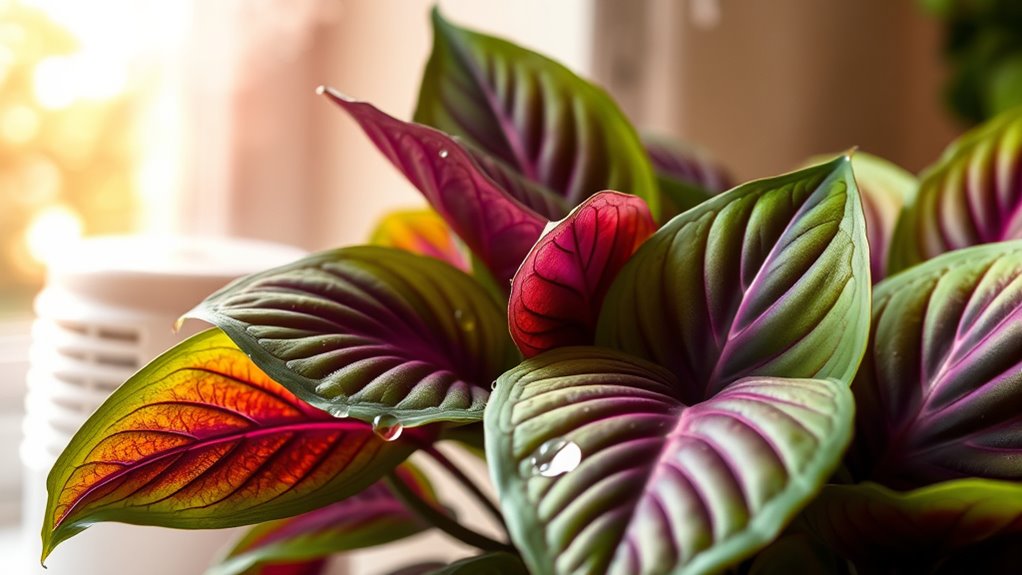
Maintaining the right humidity levels is essential for your Calathea’s healthy growth, as dry air can cause leaf edges to turn brown and curling. If you notice your plant’s leaves not opening, it might be due to insufficient humidity. To boost moisture, consider placing a humidifier nearby or setting the pot on a tray filled with pebbles and water. Be cautious of mistaken watering; overwatering can lead to root problems that hinder humidity absorption. Also, avoid over-fertilizing, which can stress the plant and worsen leaf issues. Regularly mist the leaves or use a humidifier to create a consistently moist environment. Proper humidity supports leaf unfurling and overall crucial vitality, helping your Calathea thrive. Additionally, understanding plant care fundamentals can help you identify and resolve environmental issues more effectively. Ensuring optimal humidity levels can also enhance the plant’s ability to promote healthy leaf growth, and being mindful of fire safety regulations when using electrical devices like humidifiers can prevent hazards.
Optimizing Lighting Conditions for Your Calathea
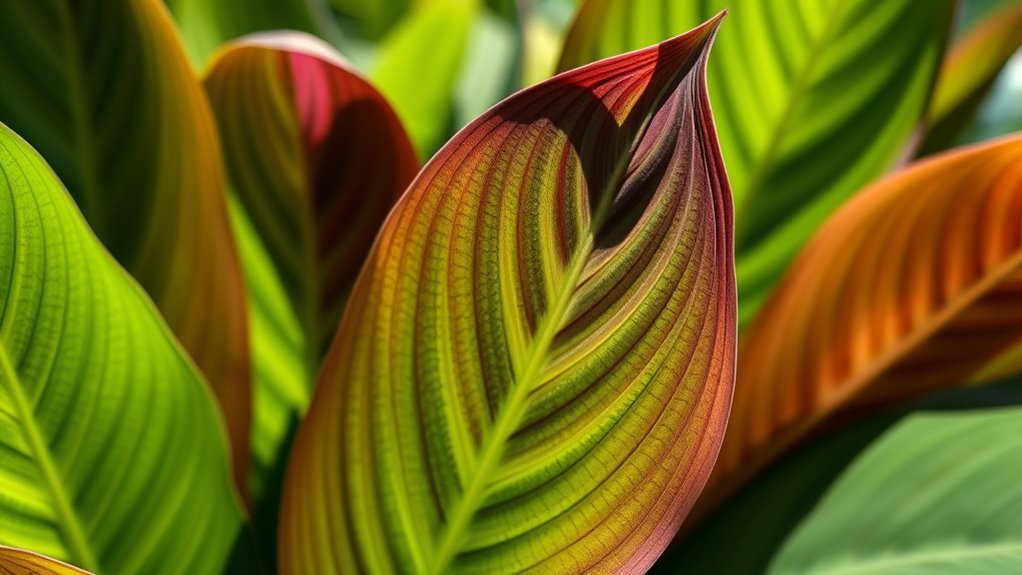
Ensuring your Calathea receives the right amount of indirect light can make a noticeable difference in its health and leaf development. Too much direct sunlight can scorch its leaves, while too little light may cause the leaves to stop opening. If natural light is limited, consider using artificial lighting, such as grow lights, to supplement the light without overheating the plant. Keep soil moisture consistent; overly dry or soggy soil can stress your Calathea, affecting its ability to thrive under ideal lighting. Place your plant near a bright, filtered light source, avoiding direct sunlight, and monitor soil moisture regularly. Proper lighting and soil conditions work together to encourage healthy leaf movement and overall vitality. Understanding plant needs can help you tailor your care to prevent leaf issues. Additionally, integrating AI-powered lighting solutions can optimize light levels based on your plant’s specific requirements, ensuring it receives the appropriate light spectrum for optimal growth.
Additional Tips to Encourage Leaf Opening
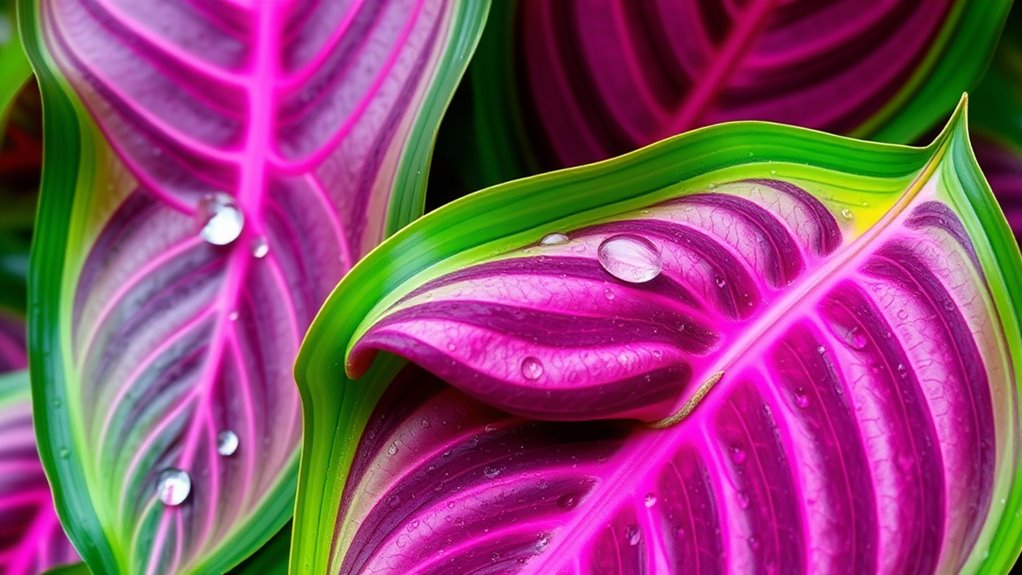
To encourage your Calathea leaves to open fully, focus on maintaining a stable environment. Proper watering frequency is essential—water when the top inch of soil feels dry, but avoid overwatering, which can lead to root rot. Guarantee your plant’s soil drains well; poor drainage traps excess moisture and hampers leaf development. Use a pot with drainage holes and a light, airy soil mix to promote healthy roots. Consistent watering prevents stress that keeps leaves closed, while good soil drainage stops water from stagnating. Additionally, maintaining even humidity and avoiding sudden temperature changes support leaf expansion. Ensuring optimal soil moisture levels helps your Calathea thrive and encourages vibrant, fully opened leaves. By keeping these factors in check, you create ideal conditions that encourage your Calathea to display its vibrant, fully opened leaves.
Common Mistakes to Avoid When Caring for Calathea
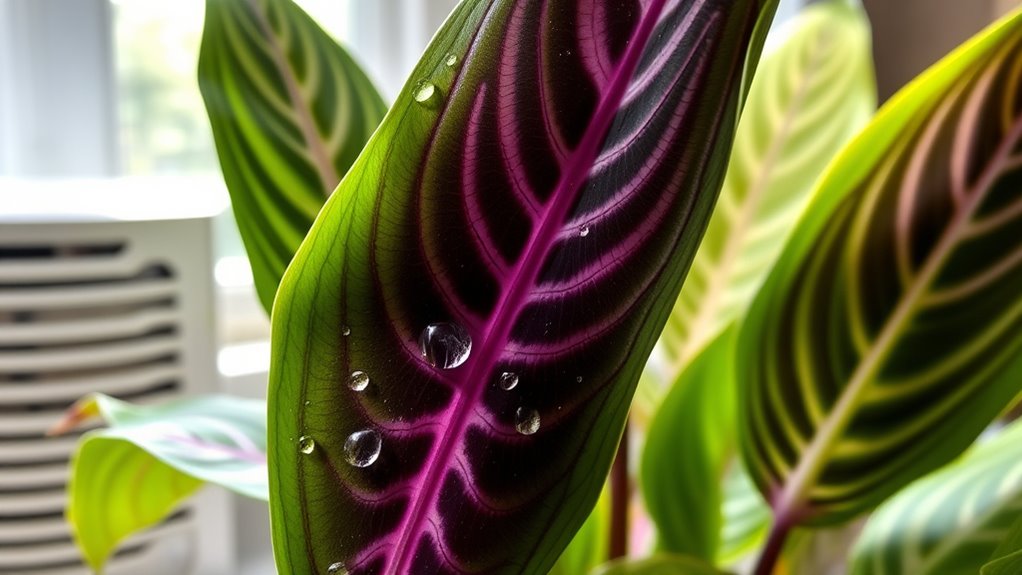
One of the most common mistakes when caring for Calathea is overwatering, which can lead to root rot and stressed leaves. Avoid watering mistakes by checking the soil moisture before watering; don’t let your plant sit in soggy soil. Overwatering can also cause the leaves to curl or develop brown tips. Additionally, fertilizer overfeeding is a frequent error; too much fertilizer can burn the roots and hinder leaf opening. Use a balanced, diluted fertilizer only during the growing season, and follow recommended schedules. Remember, Calathea prefers consistently moist but well-drained soil. Overdoing either watering or fertilizing creates stress and prevents your plant from thriving. Being mindful of these common pitfalls helps keep your Calathea healthy and encourages those beautiful leaves to open fully.
Frequently Asked Questions
Can Calathea Leaves Open at Night Without Issues?
You might notice your Calathea leaves close or fold at night, which is normal due to their natural nighttime leaf behavior. This isn’t a problem and actually helps them conserve energy. Calatheas are light-sensitive, so they respond to changes in light, closing their leaves in darkness. As long as you provide appropriate light during the day, their nighttime behavior is typical, and they won’t face issues opening their leaves in the morning.
Do Temperature Changes Affect Calathea Leaf Unfurling?
Think of your calathea as a delicate dancer, responding to the stage’s temperature. Temperature stress can disrupt its rhythm, affecting leaf orientation and preventing unfurling. Sudden or extreme temperature changes cause it to hesitate, like pausing mid-performance. To keep your plant thriving, maintain consistent warmth, avoiding drafts or cold spots. Stable temperatures support natural leaf movement, encouraging your calathea to unfurl its leaves gracefully, just like a dancer completing a perfect move.
How Often Should I Mist My Calathea for Best Results?
You should mist your calathea daily to boost humidity, especially if your home is dry. This helps keep the leaves healthy and encourages unfolding. While misting, consider plant pruning to remove any dead leaves, promoting new growth. Also, guarantee proper soil aeration by gently loosening the soil around the plant, which improves moisture absorption. Regular misting combined with pruning and soil care keeps your calathea vibrant and encourages those beautiful leaves to open fully.
Is Fertilizing Necessary to Promote Leaf Opening?
You wonder if fertilizing is necessary to promote leaf opening. Fertilizer benefits your Calathea by providing essential nutrients that support healthy growth and vibrant leaves. Without proper fertilization, nutrient deficiencies can occur, dulling leaf color and slowing growth. Regular, balanced feeding encourages new leaves to unfurl and flourish, making your plant more lively. So, yes, consistent fertilizing helps your Calathea’s leaves open fully and stay healthy.
Can Overwatering Prevent Calathea Leaves From Unfurling?
Overwatering can definitely prevent your Calathea leaves from unfurling. Excess water causes root issues like rot, which hampers nutrient absorption and weakens the plant’s ability to produce new growth. When roots are unhealthy, watering issues become more frequent, and leaves stay closed or droop. To fix this, let the soil dry out between waterings, guarantee proper drainage, and check root health regularly to promote healthy leaf development.
Conclusion
By adjusting humidity and light levels, you can transform your Calathea into a vibrant, leaf-unfurling masterpiece. Don’t underestimate the power of proper care—these simple tweaks can release the plant’s full potential, turning it into a lush, eye-catching focal point. With patience and attention, your Calathea will thrive like a tropical jewel, revealing its stunning foliage and vibrant personality. Keep nurturing it, and watch your plant flourish into a true botanical marvel.
